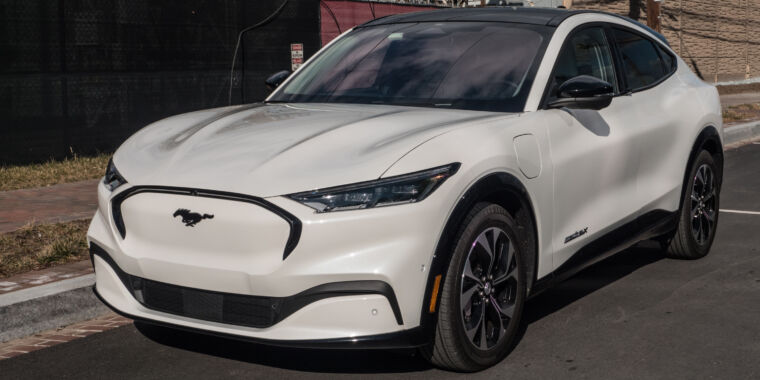Jonathan Gitlin
Ford is reopening its order books for the Mustang Mach-E battery-electric vehicle, and it’s cutting prices in the process. The automaker has also switched battery chemistry for the standard-range models, boosting their power and range in the process. The price drops were announced shortly after Ford’s Q1 2023 financial results were published, and it was a good three months for the company, which saw profits grow 20 percent, year on year.
“We continue to find ways to improve the value of the Mustang Mach-E. Upgraded BlueCruise rolling out for new and existing Mustang Mach-E owners, increased range and faster DC charging times on standard range models show how we are relentlessly improving our products for our customers,” said Marin Gjaja, chief customer officer at Ford Model e.
Ford’s switch to LFP (or lithium iron phosphate) batteries has been in the works for some time now. The cell chemistry has a lower energy density than the nickel cobalt manganese cells that are more common in US and European BEVs, but it’s also much less susceptible to thermal runaway and requires much less crash protection as a result. Consequently, LFP battery packs can devote more volume to cells, and while cell energy density is worse than NCM, things don’t look quite so bad at the pack level.
LFP batteries have some other advantages. They don’t mind being fully charged more often, and Ford says that DC fast charging times have decreased with the new pack such that it now takes 33 minutes to recharge from 10-80 percent, saving five minutes on NCM-powered Mach-Es.
You said price cut?
As a result, the rear-wheel drive standard-range Mach-E now costs $42,995—a $3,000 price drop—and should go 250 miles (402 km) from its 72 kWh battery pack. The all-wheel drive standard range also drops $3,000 to $48,995, and in addition to more range—now 226 miles (364 km)—also gets a 45 hp (34 kW) power boost to 311 hp (232 kW).
The standard range Mach-Es aren’t the only electric Mustang crossovers to get a price cut. The California Route 1 edition drops by $1,000 to $56,995, and Ford has cut $4,000 from the Premium standard-range variants (RWD $46,995, AWD $49,995). The extended-range Mach-E Premium remains unchanged.
My favorite Mach-E also gets a $4,000 price cut, as the Mach-E GT now starts at $59,995. And Ford has also made the GT Performance Edition package $1,000 cheaper—ticking this option transforms the way the car drives by adding much better tires and magnetorheological dampers.
These are Ford’s second EV price cuts in 2023—in January it cut between $900-$5,900 from Mach-E prices. Ford is also giving all Mustang Mach-E customers a 90-day free trial of BlueCruise, its hands-free highway driving assist.
Making money
As previously reported, Ford says its Model e division, which is responsible for developing BEVs, will lose money this year, probably as much as $3 billion. That’s because Ford is investing heavily in growing its capacity to build EVs—by the end of this year it should be churning out 600,000 a year, split between the Mustang Mach-E, F-150 Lightning pickup truck, and E-Transit van.
Luckily for the Blue Oval, it can afford to treat Model e like a loss-making startup as that division ramps up production and becomes profitable. Ford Blue, which is responsible for the rest of the automaker’s consumer-oriented vehicles, brought in $25.1 billion in revenue in Q1, and Ford Pro, which handles commercial vehicles, brought in another $13.2 billion.
In all, Ford earned $41.5 billion in revenue for the first three months of the year, an increase of 20 percent year on year. In the process it sold 1.1 million vehicles, a 9 percent growth on Q1 2022. Profits for the quarter were $1.8 billion, compared to a $3.1 billion loss for Q1 2022, albeit a loss mostly attributable to Ford’s investment in EV startup Rivian.


